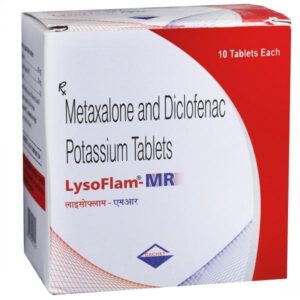DICLOFENAC + SERRATIOPEPTIDASE + PARACETAMOL.
Diclofenac: Diclofenac is a nonsteroidal anti-inflammatory drug (NSAID) commonly used to relieve pain and reduce inflammation. It is available in various forms, including tablets, capsules, gels, creams, and patches.
The mechanism of action of diclofenac involves inhibiting the enzyme cyclooxygenase (COX), thereby reducing the production of inflammatory chemicals called prostaglandins. By decreasing the levels of prostaglandins, diclofenac helps to alleviate pain, swelling, and inflammation.
Diclofenac is prescribed for a range of conditions, including rheumatoid arthritis, osteoarthritis, ankylosing spondylitis, gout, and menstrual pain. It can also be used to relieve pain caused by injuries, surgeries, and dental procedures.
The dosage of diclofenac varies depending on the condition being treated and the formulation used. For oral tablets or capsules, the usual starting dose is 75-150 mg per day, divided into two or three doses. The maximum daily dose should not exceed 150 mg. If using topical forms like gels or creams, a thin layer is usually applied to the affected area three to four times daily.
Like other NSAIDs, diclofenac can have side effects. Common side effects may include headache, dizziness, gastrointestinal disturbances (such as stomach pain, indigestion, and diarrhea), rash, fluid retention, and elevated blood pressure. Uncommon but serious side effects can include gastrointestinal bleeding, ulcers, liver or kidney problems, and allergic reactions. Long-term use or high doses may increase the risk of these side effects.
It is important to follow the prescribed dosage and duration of treatment to minimize the risk of adverse effects. Individuals with a history of gastrointestinal bleeding, ulcers, heart disease, high blood pressure, or liver/kidney problems should use diclofenac with caution and under medical supervision. It is also advisable to avoid combining diclofenac with other NSAIDs or blood-thinning medications unless specifically directed by a healthcare professional.
As with any medication, it is crucial to consult a healthcare provider or pharmacist for specific dosing instructions, potential drug interactions, and to discuss any concerns or questions before starting diclofenac.
Serratiopeptidase: Serratiopeptidase, also known as serrapeptase, is a proteolytic enzyme derived from the bacterium Serratia marcescens. It is commonly used as an anti-inflammatory and analgesic agent.
The mechanism of action of serratiopeptidase involves the breakdown of proteins and peptides in inflammatory tissues, which helps reduce swelling and pain. It helps to remove scar tissue and improve tissue healing by enhancing the body’s natural processes.
Serratiopeptidase is available in the form of tablets and is typically taken orally. The recommended dosage varies depending on the condition being treated and the strength of the medication, usually ranging from 10 – 30 mg per day. It is important to follow the instructions provided by the healthcare professional or the product label.
Common side effects of serratiopeptidase include gastrointestinal discomfort, such as nausea, diarrhea, and stomach pain. Some individuals may also experience allergic reactions, such as skin rashes, itching, or swelling. In rare cases, it can cause more severe adverse effects such as allergic bronchospasm, anaphylaxis, or bleeding disorders.
As with any medication, it is important to consult with a healthcare professional before using serratiopeptidase. This is particularly important for individuals with a history of bleeding disorders or those taking medications that increase the risk of bleeding, such as anticoagulants or antiplatelet drugs. Additionally, it is important to disclose any other medications or supplements being taken to ensure there are no potential drug interactions.
Paracetamol.: Paracetamol, also known as acetaminophen, is a commonly used over-the-counter medication for pain relief and fever reduction. It belongs to a class of drugs called analgesics (pain relievers) and antipyretics (fever reducers).
Paracetamol’s mechanism of action is not fully understood, but it is believed to work by inhibiting the production of prostaglandins, which are responsible for transmitting pain signals and promoting inflammation in the body. By reducing the production of prostaglandins, Paracetamol helps to alleviate pain and reduce fever.
The recommended dose of Paracetamol varies depending on the age and weight of the individual. In adults, the usual oral dose is 325-1000 mg every 4-6 hours as needed for pain relief or fever reduction. The maximum daily dose should not exceed 4000 mg in adults, and dose intervals should be extended for individuals with liver or kidney impairment.
Paracetamol is generally considered safe when used as directed. However, it can cause side effects in some individuals. Common side effects include nausea, upset stomach, and rash. In rare cases, it can cause a serious skin condition known as Stevens-Johnson syndrome. Overdosing on Paracetamol can result in liver damage, so it is important to adhere to the recommended dosage and consult a healthcare professional if symptoms persist or worsen.
It is worth noting that Paracetamol should not be used in individuals with liver disease, as it can worsen liver function. Additionally, individuals who consume alcohol regularly should use Paracetamol with caution, as alcohol can increase the risk of liver damage when combined with Paracetamol.
As with any medication, it is recommended to consult a healthcare professional or read the product labeling for specific instructions and to ensure safe and appropriate use.

